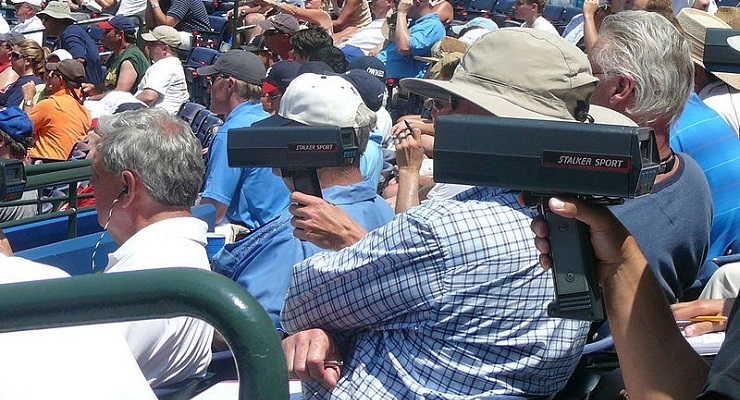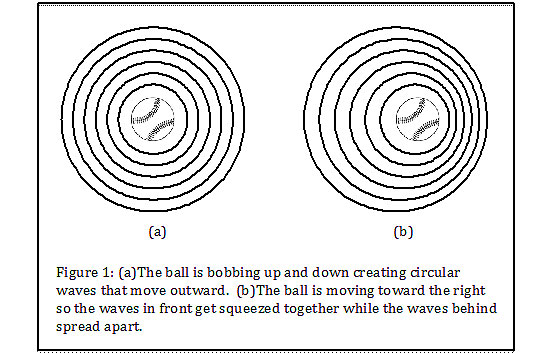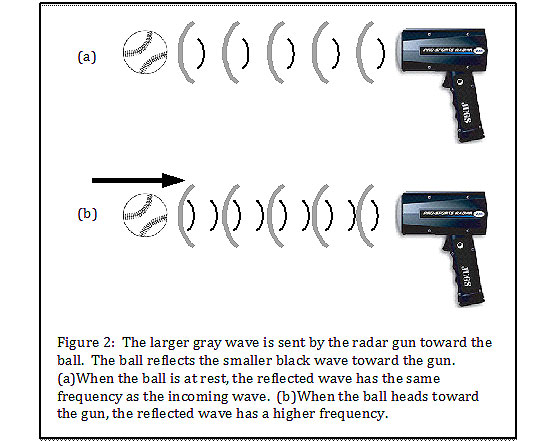The Physics of Radar Guns

The radar gun can only accurately measure pitch velocity from behind the plate. (via Chris J. Nelson)
In 1940 a young outfielder by the name of Danny Litwhiler joined one of the worst teams in the history of the National League, the Philadelphia Phillies. From 1940 through 1942 the Phils finished last each year, compiling a combined record of only 135 wins against 323 loses. Yes, that required three consecutive 100-loss seasons.
Despite his dismal team in 1942, Litwhiler accomplished the rare feat of completing the season without a single error, and he was the first ever to do so. For this reason, his glove is in the Hall of Fame. During an interview in 2005, he stated it may have been the first glove on which the fingers were stitched together with rawhide.
Few have disputed his claim. True or not, Litwhiler was a prodigious baseball innovator. In 1956 he created Diamond Grit to dry infield dirt after a rain. In 1962 he was awarded a patent for the batting cage. Finally and to the point, in 1974 he brought the idea of a handheld radar gun to the JUGS Sports company.
We know radar was invented in World War II, but by the early 1970s police were routinely using it to catch speeders. Litwhiler, by then the baseball coach at Michigan State, either read a story about radar use by the campus cops or drove by and saw them using it, or perhaps he was pulled over for speeding. The details are murky.
In any case, he immediately saw the potential of radar as a teaching tool for baseball. He was particularly interested in helping pitchers increase the speed differential between their fastball and change-up. Of course, the JUGS gun has become an indispensable tool for scouts and coaches throughout baseball. The reading from a gun is displayed after ever pitch in almost every major league stadium.
Radar is not actually a word, it is an acronym. It stands for radio detection and ranging, which sort of describes how it works. Just like an echo is a sound wave that bounces off something and returns, radar is a radio (electromagnetic) wave that does the same thing.
Radio waves all travel at the same speed; 186,000 miles per second (the speed of light) or about one foot in a billionth of a second. So, first measure the time for the wave to go from the radar gun to the ball and back. Then multiply the time by the speed of the wave to find the distance to the ball and back to the gun. Divide by two and you have the distance to the ball.
Actually, handheld radar guns don’t measure distance because all you really expect from them is the speed of the ball. It turns out the frequency of the waves that return from the ball is slightly different than the frequency of the waves emitted by the gun. This is called the “Doppler Effect,” the same Doppler as in a weather reporter’s Doppler radar.
You can hear the Doppler Effect for sound waves if you stand by a busy highway. The sound of a vehicle coming toward you has a higher frequency than it does when it is heading away from you. You can really notice the change just as the vehicle passes.
Last year Mike Trout of the Angels got his first, much anticipated, trip to the postseason. It began poorly and didn’t end well. He went 0-for-8 in the first two games of the American League Division Series against Kansas City. In the first inning of the third game, he crushed a blast into the fountains at Kauffman Stadium, but it wasn’t enough. Kansas City won the series and eventually went on to the World Series.
Let’s start to understand the Doppler Effect by thinking about that home run ball bobbing up and down in the fountain. Each oscillation creates a circular wave that travels away from the ball. Figure 1A shows the ball bobbing up and down (in this view, into and out of the page). The crests of the resulting waves move away from the ball in perfect circles.

Figure 1B shows the bobbing baseball moving toward the right. This motion causes the waves to be closer together in front of the ball and further apart behind the ball. So if the ball is moving toward you, will measure the frequency of the waves to be higher. If the ball is moving away from you, the frequency will be lower.
From Figure 1 you might guess this change in frequency depends upon how fast the ball is moving, and you would be correct. The Doppler radar uses the change in frequency to find the speed of the ball.

The ball in the fountain makes waves by pushing water as it moves up and down. For a pitch heading toward the plate, the ball doesn’t make waves. Instead, it reflects the waves sent at it by the radar gun as shown in Figure 2. If the ball is at rest, the waves reflect off it at the same frequency as they arrive as shown in Figure 2A.
When the ball comes toward the radar gun as shown in Figure 2B, the waves it sends back to the gun have a higher frequency. The radar detector inside the gun sends the change in frequency to an internal computer that calculates and displays the speed of the ball.
One downside of a basic radar gun is the speed it records is only the part of the speed along the direction you point the gun. That explains why people using radar guns congregate behind home plate. That’s the only spot where it measures the correct pitch speed.
TrackMan
TrackMan is a Doppler radar-based product of a Danish company. Its web site doesn’t really tell you much about how it works. The best information about Trackman can be found at Alan Nathan’s Physics of Baseball site.
A radar gun can measure speed only in the direction of the gun because the source of the radio waves and the detector are both housed in the gun. A full TrackMan installation includes a source and three widely spaced detectors giving the full three-dimensional motion of the ball. TrackMan can collect this data for pitches as well as hit baseballs.
TrackMan can track not only the trajectory, speed, and direction of the ball but also the spin of the ball. The radar signal reflected by the ball flickers. The frequency of the flickering matches the spin rate of the ball. There are two suggestions as to the source of the flickering.
Different parts of the ball probably reflect different amounts of the radar waves. Perhaps the seams are more or less reflective than the horsehide. Maybe the lettering or logo on the ball reflects differently.
The more likely explanation is that different parts of a spinning ball are moving at different speeds. Imagine a ball with topspin moving directly at you. The top of the ball would be moving toward you a little faster than the middle of the ball which in turn is moving a bit faster than the bottom of the ball. Since the Doppler Effect depends upon the speed of the reflecting surface, the variation in speed across the ball could be causing the flickering.
StatCast
On Opening Day of 2015, the next generation of technology was supposed to begin operation in all 30 major league ballparks. The system uses Trackman to follow the ball throughout the ballpark. In addition, video technology from ChyronHego was to monitor the motion of every player at all times.
Radar is much better for monitoring the ball because it travels so rapidly. Players, on the other hand are slow – at least compared to the ball. Video is more than sufficient to track their movements using a method similar to the way PITCHf/x tracks a pitch.
MLB Advanced Media plans to use the raw data to generate quantities useful to players, coaches and fans. The numbers and graphics generated from the system for the fans is collectively known as “StatCast.” Perhaps you saw StatCast video in action during the big rollout on April 21, 2015, as the Nationals hosted the Cardinals. If not, samples are available at MLB.com.
Table 1 summarizes just some of the data that are collected and displayed by StatCast:
| Partial Summary of Data Collected by StatCast |
|---|
| Play Type | Data |
| Fly ball | Launch velocity, launch angle, hang time, travel distance, max height |
| Fielding | 1st step time, acceleration, max speed, distance covered, route efficiency, throw release time, throw initial velocity |
| Baserunning | lead length, secondary lead length, max speed, 1st step time, time between bases |
| Pitching | Extension, velocity, spin rate, pitch type |
StatCast has the ability to simply overwhelm us with data and visuals. Whether or not all this enhances the game for the fans is strongly dependent upon being able to display cleanly and clearly the data fans want to know. We’ll see what happens as MLBAM continues with the rollout.

What is the difference between stat cast and the new field fx technology?
The two suggestions given for how Trackman measures the spin rate are not an “either-or” choice. Actually both of those explanations are essential to the technique. The patent application that describes the technique can be found at this link:
http://baseball.physics.illinois.edu/trackman/SpinParametersSportsBallPatent.pdf.
I had never even heard of Danny Litwhiler until this article, but between his playing career, coaching career, and inventions he just might be baseball’s ultimate Renaissance Man:
http://www.baseball-reference.com/bullpen/Danny_Litwhiler
Is there such thing as a “hot” or “cold” radar gun? In other words, is it necessary to calibrate the instrument before recording data?
The reading from a gun is displayed after ever pitch in almost every major league stadium.
Actually, by 2010 more than half the stadiums had switched to using the Pitch Fx estimates of the speed of the pitched ball for their stadium scoreboards. I would guess that that percentage is even greater now.
any explanation about which velocity is measured by the radar guns? Out of hand at max velocity? Or average velocity between catcher and pitcher?
Usually the hand-held devices are programmed to give the maximum velocity, so that means out of hand.
Not to quibble over details but could you not also measure the velocity of the pitch from directly behind the pitcher. If you had a radar gun in the direct centerfield bleachers could you not also measure the pitch’s velocity correctly? Instead of the positive velocity or difference in frequency it would be negative but it should still be measureable. Of course then you have the problem of the pitcher being in the way of the measurement.